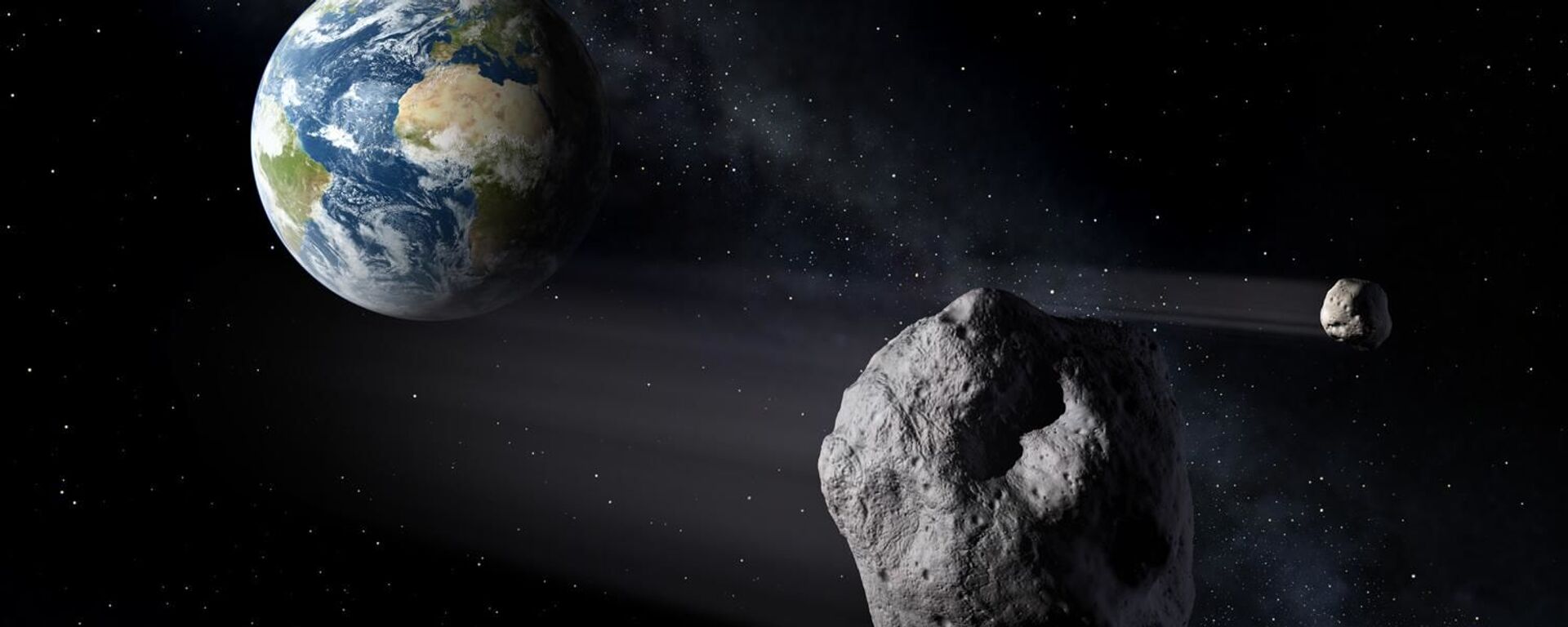https://sputnikglobe.com/20220116/do-look-up-some-asteroids-can-creep-up-on-earth-undetected-nasa-warns-1092296515.html
Do Look Up: Some Asteroids Can Creep Up on Earth Undetected, NASA Warns
Do Look Up: Some Asteroids Can Creep Up on Earth Undetected, NASA Warns
Sputnik International
NASA is currently working on a 2005 task outlined by the US Congress to catalogue and track an absolute majority of potentially dangerous NEOs – objects in... 16.01.2022, Sputnik International
2022-01-16T12:57+0000
2022-01-16T12:57+0000
2023-04-12T16:57+0000
world
space
https://cdn1.img.sputnikglobe.com/img/107927/25/1079272579_0:0:3641:2048_1920x0_80_0_0_93ddc6b097819bfb6b27f60885e82912.jpg
As opposed to what you might see in the Netflix satire "Don't Look Up", the US and specifically NASA goes to great lengths to monitor objects in space that might endanger Earth. And so, when a 100-metre asteroid, called 2019 OK, snuck up and surprised astronomers just 24 hours before passing 70,000 km from Earth (for comparison, the Moon circles the planet at a distance of 384,400 km) in 2019 they rushed to find out how it could have caught them unawares.A group of NASA-funded scientists have finally determined that the Earth's monitoring system, consisting of dozens of computerised telescopes, has a "blind spot" in the eastern portion of the sky during the night, according to their research published in the scientific journal Icarus.Due to the peculiarities of Earth's elliptic orbit around the Sun and the planet's eastward spin, some space objects might appear stationary when looked at through a telescope. Normally, near-Earth objects (NEOs) appear as drifting westward in the sky, but around half of them approaching the planet "from the east" might fall into this blind spot and remain undetected for a long period of time.The computerised system of telescopes ignores "stationary objects" so that supernovas would not confuse it. Yet, this contingency also allowed for 2019 OK to remain undetected instead of being spotted a month ahead of its passage near Earth. That means that this specific portion of the sky will have to be looked at more closely, the researchers said.They also expect that telescope systems may be updated to negate the effect of some space objects appearing stationary.The US Congress tasked NASA with monitoring 90% of NEOs sized 140 metres or larger in 2005. To this day, around 40% of these objects have been catalogued. Washington has also allocated money for various planetary defence programmes over the years. One of them, Double Asteroid Redirection Test (DART), studies the concept of diverting dangerous NEOs away from the planet by crashing a spacecraft into them.
https://sputnikglobe.com/20210812/potentially-hazardous-asteroid-bennu-may-collide-with-earth-in-2182-warns-nasa-1083587008.html
Sputnik International
feedback@sputniknews.com
+74956456601
MIA „Rossiya Segodnya“
2022
Tim Korso
https://cdn1.img.sputnikglobe.com/img/07e6/03/0d/1093831826_0:0:216:216_100x100_80_0_0_e3f43a960af0c6c99f7eb8ccbf5f812c.jpg
Tim Korso
https://cdn1.img.sputnikglobe.com/img/07e6/03/0d/1093831826_0:0:216:216_100x100_80_0_0_e3f43a960af0c6c99f7eb8ccbf5f812c.jpg
News
en_EN
Sputnik International
feedback@sputniknews.com
+74956456601
MIA „Rossiya Segodnya“
Sputnik International
feedback@sputniknews.com
+74956456601
MIA „Rossiya Segodnya“
Tim Korso
https://cdn1.img.sputnikglobe.com/img/07e6/03/0d/1093831826_0:0:216:216_100x100_80_0_0_e3f43a960af0c6c99f7eb8ccbf5f812c.jpg
space
Do Look Up: Some Asteroids Can Creep Up on Earth Undetected, NASA Warns
12:57 GMT 16.01.2022 (Updated: 16:57 GMT 12.04.2023) NASA is currently working on a 2005 task outlined by the US Congress to catalogue and track an absolute majority of potentially dangerous NEOs – objects in space that come as close as 45 million kilometres to Earth's orbit around the Sun.
As opposed to what you might see in the Netflix satire "Don't Look Up", the US and specifically NASA goes to great lengths to monitor objects in space that might endanger Earth. And so, when a 100-metre asteroid, called 2019 OK, snuck up and surprised astronomers just 24 hours before passing
70,000 km from Earth (for comparison, the Moon circles the planet at a distance of 384,400 km) in 2019 they rushed to find out how it could have caught them unawares.
A group of NASA-funded scientists have finally determined that the Earth's monitoring system, consisting of dozens of computerised telescopes, has a "blind spot" in the eastern portion of the sky during the night, according to their research published in the scientific journal Icarus.

12 August 2021, 12:05 GMT
Due to the peculiarities of Earth's elliptic orbit around the Sun and the planet's eastward spin, some space objects might appear stationary when looked at through a telescope. Normally, near-Earth objects (NEOs) appear as drifting westward in the sky, but around half of them approaching the planet "from the east" might fall into this blind spot and remain undetected for a long period of time.
The computerised system of telescopes ignores "stationary objects" so that supernovas would not confuse it. Yet, this contingency also allowed for 2019 OK to remain undetected instead of being spotted a month ahead of its passage near Earth. That means that this specific portion of the sky will have to be looked at more closely, the researchers said.
"Surveys should take extra care when surveying the sky in this direction, and aggressively follow up new slow-moving objects", the team of NASA-backed scientists concluded in their research.
They also expect that telescope systems may be updated to negate the effect of some space objects appearing stationary.
The US Congress tasked NASA with monitoring 90% of NEOs sized 140 metres or larger in 2005. To this day, around 40% of these objects have been catalogued. Washington has also allocated money for various
planetary defence programmes over the years. One of them, Double Asteroid Redirection Test (DART), studies the concept of diverting dangerous NEOs away from the planet by crashing a spacecraft into them.




